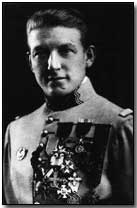The War in the Air - Air Aces of World War One
 The First World War introduced a new form of battleground: to ground and sea warfare could now
be added aerial conflict. Nascent aircraft technology was quickly and
relentlessly developed to produce machines capable of serving each country
initially in reconnaissance missions (ideal in conditions of trench warfare)
and later in fighter and bombing raids.
The First World War introduced a new form of battleground: to ground and sea warfare could now
be added aerial conflict. Nascent aircraft technology was quickly and
relentlessly developed to produce machines capable of serving each country
initially in reconnaissance missions (ideal in conditions of trench warfare)
and later in fighter and bombing raids.
The air war threw up a new breed of fighter, and in general the Allied and Central Powers' governments proved quick in exploiting the successes of their airmen for propaganda purposes (although the British were less inclined to trumpet the Royal Flying Corps' achievements, with one or two notable exceptions).
The French government was the first to award the distinction of 'ace' to those of their fighters who had demonstrably downed five enemy aircraft. Independent confirmation was a strict requirement however, which often posed a practical difficulty in crowded dogfight circumstances.
 The German government
quickly followed, specifying however that eight (later sixteen) 'kills' were
required for a pilot to be considered an ace and eligible for the
prestigious Pour le Merite award.
The German government
quickly followed, specifying however that eight (later sixteen) 'kills' were
required for a pilot to be considered an ace and eligible for the
prestigious Pour le Merite award.
Britain - and later the U.S. - followed the French example, although both were more lenient in allowing 'probable' victories to count. The British Distinguished Flying Cross was available to those pilots who had scored at least eight victories.
Most victories were scored in the crowded skies above the Western Front. Even then reliable statistics are not easy to come by: figures for the other fronts (e.g. the war in the East) are even more unreliable.
It was routine for pilots to claim 'kill' figures notably higher than their official figures. Some units also instated regimes whereby 'easy' targets were to be left to the leading aces, thus further boosting their totals (much to the resentment of junior pilots).
The table below lists the top twenty airmen of the war. The 'Red Baron', Manfred von Richthofen, scored the highest number of victories of the war, although Frenchman Rene Fonck was the highest scorer to survive the war.
Links are provided to pages containing biographical sketches of individual pilots. Click here for a full listing of those available on this site. Click here to view this site's section specific to the air war.
Top 20 Fighter Pilots
| Pilot | Score |
|---|---|
| Manfred von Richthofen | 80 |
| Rene Fonck | 75 |
| William Bishop | 72 |
| Ernst Udet | 62 |
| Edward Mannock | 61 |
| Raymond Collishaw | 60 |
| James McCudden | 57 |
| Andrew Beauchamp-Proctor | 54 |
| Georges Guynemer | 54 |
| Erich Lowenhardt | 54 |
| Donald MacLaren | 54 |
| William Barker | 52 |
| Josef Jacobs | 48 |
| Werner Voss | 48 |
| George McElroy | 47 |
| Robert Little | 47 |
| Charles Nungesser | 45 |
| Fritz Rumey | 45 |
| Rudolf Berthold | 44 |
| Albert Ball | 44-47 |
Top Aces by Nation
| Country | Pilot | Score |
|---|---|---|
| Germany | Manfred von Richthofen | 80 |
| France | Rene Fonck | 75 |
| Canada | William Bishop | 72 |
| UK | Edward Mannock | 61 |
| South Africa | A. Beauchamp-Proctor | 47 |
| Australia | Robert Little | 47 |
| Ireland | George McElroy | 47 |
| Belgium | Willy Coppens | 37 |
| Austria-Hungary | Godwin Brumowski | 35 |
| Italy | Francesco Baracca | 34 |
| USA | Eddie Rickenbacker | 26 |
| Russia | Alexei Kazakov | 17 |
By 1918 the percentage of women to men working in Britain had risen to 37% from 24% at the start of the war.
- Did you know?
